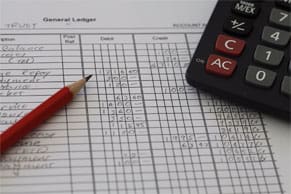Business leaders in companies of all sizes and industries questions daily as they try to make sense of current results and determine decisions for the future. What changed? Why did it change? Variance analysis is a crucial tool for answering those questions. Also called flux analysis, variance analysis compares two pieces of data and displays the quantitative difference between them, as well as the underlying reason—think budget versus actuals or current year compared to prior year. It should be performed regularly, but some organizations let it slide because it can be tedious and time-consuming. Here’s what business leaders need to know about variance analysis, including how to do it and why you shouldn’t let it slip.
What Is Variance Analysis?
Variance analysis is an exercise that businesses use to analyze and investigate changes in financial data. It can be the comparison of any two points—commonly, comparing current actual results to a benchmark, such as a budget, forecast, or prior period. Its goal is to quantify the degree of change and provide a comprehensive explanation, which it does through a combination of numeric and textual descriptions. Information provided by variance analysis helps company leaders understand what is going on in the business, relative to the expectations established by the benchmark, so they can decide whether operational course corrections are needed. In this way, it informs future business decisions and helps companies build flexible budgeting processes.
In addition, variance analysis is a useful tool for uncovering accounting errors or omissions and can raise a red flag on unusual activity that might indicate fraud. Through examination of fluctuations, variance analysis acts as a detective control, similar to account reconciliations. For this reason, auditors often begin and end a financial statement audit with a variance analysis as a “reasonableness test”—a high-level review to identify anything that looks out of whack. When used in this way, the desired variance analysis would be between current actual financials and a prior period’s audited financials.
Key Takeaways
- Variance analysis compares two sets of financial data and provides quantitative and qualitative explanations for any differences.
- It’s a practical tool for managing current operations and informing future plans, as well as an effective detective control to flag errors and anomalies in financial information.
- Variances are often the result of changes in the volume, cost, or efficiency of an activity—or any combination of the three.
- Capturing high-quality data in accounting software helps make variance analysis less time-consuming and timelier, and it facilitates richer, more actionable explanations.
Variance (Flux) Analysis Explained
Most often, variance analysis is performed at the end of a financial close to compare the actual results for a period against another benchmark, such as the budget. It can be applied to all levels of financial information—broadly, to financial statements, and granularly, to general ledger accounts. For example, variance analysis can be prepared for the total revenue line on an income statement to compare current period actuals to the budgeted levels. Or it can be done for one particular revenue account to understand the changes happening to, say, a product, assessing specific factors such as volume sold and price, as well as related changes such as the rate of returns. Variance analysis usually is performed on all three of the major financial statements: the balance sheet, income statement, and cash flow statement. It can focus on any of the components of those statements, such as assets, liabilities, revenue, expenses, and cash flow. and cash flow.
Why Is Variance Analysis Important?
Variance analysis is a simple but powerful technique that helps accounting teams maintain accurate records by uncovering errors or omissions in accounting data. Not only does this improve precision, it also ensures that all data feeding into other analyses is reliable, preventing decision-makers from being misled.
Variance analysis is also valuable for detecting fraud, especially when actual results are compared to expected values, such as a forecast. Unusual activity can signal potential irregularities and prompt additional scrutiny.
But most importantly, variance analysis helps business leaders “manage by exception.” This means pinpointing and prioritizing areas that need attention because an activity is not going as planned. For example, if a variance analysis reveals that the gross margin for one of a company’s 10 products is lower than anticipated, the accounting team can focus on understanding what’s happening with that one product. As a result, variance analysis serves as a catalyst for tighter cost controls, better financial oversight, and a more precise evaluation of both product and employee performance.
Favorable vs. Unfavorable Variance
Variances are categorized as either favorable or unfavorable. A favorable variance means that the actual results are better than the point of comparison, while an unfavorable variance is where the actual results are worse. However, “better and worse” are based on the impact on profitability, not simply whether the variance is higher or lower. For example, if actual revenue is greater than budgeted revenue, that would be a favorable variance. But if actual expenses are greater than the budget, that variance would be considered unfavorable. Variance analyses typically show unfavorable variances in red and favorable variances in black. Additionally, unfavorable variances may be shown in parentheses and favorable variances without.
Another important point is that favorable and unfavorable doesn’t always translate into “good and bad.” Interpretation depends on the context. If utility expenses for the month were lower than budgeted, that would be labeled a favorable variance. If it were the result of converting office space to more efficient LED lighting, this favorable variance would also be good. However, consider a similar fact pattern for sales commission expense. If the actual sales commission expense for the month were less than the amount budgeted, it would also be characterized as a favorable variance. On the other hand, if sales commissions were lower because the sales team closed fewer deals than planned during the period, this favorable variance would be bad for the business overall.
Understanding favorable and unfavorable variances helps management in several ways. It assists in performance evaluation by identifying areas of overperformance or underperformance. It is useful for deciding where to invest or cut back when allocating resources. It highlights areas that are running optimally or need improvement. Additionally, it helps with strategic planning by making budgets and forecasts more realistic.
Variance Analysis Formula
Variances are calculated to show dollar difference and the related percentage of change. While there are many possible types of variances, the variance formulas are straightforward and always the same. Dollar variance is simply the current, or new, amount for the data in question minus the “old” value for the same data (usually either from the prior period or against a benchmark, such as the budget or forecast). A common example is current-year actual minus the prior-year actual. The percentage change calculation can be thought of as “new minus old divided by old.” When performing a variance analysis of a current year balance versus the prior year, the formulas would look like this:
Dollar variance = Current year – Prior year
Percentage change = (Current year – Prior year) / Prior year
To demonstrate the formulas in action using a hypothetical example, consider SAR Sporting Goods, a fictional soccer equipment retailer, which generated $100,000 in actual sales for the month of February. Budgeted sales in the previous February were $90,000 and actual sales for the February prior to that were $120,000, for sequential sales of $120,000 (two years ago), $90,000 (one year ago), and $100,000 (current). The high-level variance analysis of overall sales is shown below. Variance explanations (a) and (b) shed additional light on the quantitative changes.
SAR Sporting Goods
Variance Analysis
February (Current)
(a) Actual sales exceeded budget due to increases in orders (up 120) and revenue per order (up $4).
(b) Actual sales were lower than in the prior year due to a non-recurring $30,000 special order in that calendar year, partially offset by increases in orders and in price.
| February 2023 Actual |
February 2023 Budget |
February 2022 Actual |
Budget $ |
vs. | Actual % |
Prior Year $ |
vs. | Actual % |
|
|---|---|---|---|---|---|---|---|---|---|
| Sales | $ 100,000 | $ 90,000 | $ 120,000 | $ 10,000 | 11% (a) | $ (20,000) | 17% (b) |
The Column Method
The column method is a way to present a variance analysis using a table format. Columns are set up side by side to show the benchmarks being compared, such as actual, budget, prior year, and forecast. The specific items for analysis, such as revenue or expenses, are listed in rows. The calculation of the variance for each item is listed in a separate column, and a designation of “F” for favorable or “U” for unfavorable is in a final column. An example of the column method is:
| Actual | Budget | Variance | F/U | |
|---|---|---|---|---|
| Revenue | $ 2,000,000 | $ 2,800,000 | $ (800,000) | U |
| Expenses | $ 130,000 | $ 150,000 | $ 20,000 | F |
| Net income | $ 1,870,000 | $ 2,650,000 | $ (780,000) | U |
The column method is easy to prepare and understand. It is also versatile and can be used for many kinds of variance analysis, such as budget versus actual, comparing financial statements for various periods, tracking sales performance against goals, and analyzing actual costs to standard costs in cost accounting. It neatly organizes the pertinent data and quickly identifies whether variances are favorable or unfavorable. The rows can be expanded for additional items, and additional columns can show a percentage change or include further benchmarks. However, a shortcoming of the column method is that it fails to show the reasons why the variances arise, which is necessary to fully interpret the results.
Most Common Types of Variances
Variances are everywhere in a business’s financial data. Income statement data tends to be a common starting point for variance analysis, focusing on fluctuations in sales and expenses. Unexpected differences in sales from a business’s budgeted expectations might come from external causes, such as shrinking markets or increased consumer demand. Differences might indicate problems with the sales team or distribution channels. For these reasons, it’s important for variance investigations to also consider operational data alongside the accounting information, which is always good practice in financial management.
Beyond the income statement, valuable information can be revealed by analyzing changes in balance sheet accounts. Fluctuations in accounts like inventory, accounts receivable, and accounts payable, for example, might represent cash flow problems, such as “hidden” sources and uses of cash, so it’s important to understand what’s causing those fluctuations.
The most common types of variances include:
-
Revenue variance:
Revenue variances relate to fluctuations in sales compared to past periods or expectations. It’s useful to understand why revenue is higher or lower than in prior periods, budgets, and forecasts.
-
Expense variance:
Changes in costs, compared to other periods and expectations, are important to analyze carefully and in the context of other fluctuations. Not all increases in costs are bad, and not all decreases are good. For example, the cost of goods sold can be lower than expected because of the lower cost of materials or because the volume of products sold for the period was lower.
-
Labor variance:
This expense variance is specific to payroll costs, including hourly, salaried, and contract workers. When labor costs are lower than those in the comparison point, it’s considered to be a favorable variance. When labor costs are higher than expected or than in a prior year, it’s generally considered unfavorable. As with all expenses, however, it’s important to understand the underlying causes to determine whether the change is good or bad.
-
Material variance:
This expense variance is specific to the cost of materials needed to produce products for sale. It includes both direct material costs, such as raw materials like timber, as well as some indirect costs, such as gloves for factory workers, and the transportation costs of obtaining the materials. When material costs are less than the comparison point, it’s thought to be a favorable variance. When material costs are higher than expected or than in a prior year, it’s generally considered an unfavorable variance. Whether higher or lower, it’s important to understand the underlying causes.
-
Overhead variance:
Overhead refers to indirect costs that a business incurs outside the direct costs of producing a product or service. A few examples are utilities, corporate staff salaries, legal fees, and interest expenses, but many other types of expenses can be classified as overhead. An overhead variance is a specific expense variance that relates to the difference between actual overhead costs and those included in the comparison point. When actual overhead is lower than its comparison value, it’s considered favorable; when it’s higher, it’s seen as unfavorable.
Typical Interpretations of the Most Common Types of Variances
| Variance Type | Actual > Benchmark | Actual < Benchmark |
|---|---|---|
| Revenue | Favorable | Unfavorable |
| Expenses | Unfavorable | Favorable |
| Labor | Unfavorable | Favorable |
| Material | Unfavorable | Favorable |
| Overhead | Unfavorable | Favorable |
Reasons for Variances
There are two broad reasons why variances arise in fluctuation analyses. The first is errors in the data, such as omissions, data-entry mistakes, and incorrect general ledger coding. Variances caused by data errors aren’t true business variances, as they can be easily fixed by the accounting staff. However, variances could indicate an issue within the business’s accounting processes, which should be addressed if they’re recurring. The second reason variances arise is due to real changes in operations relative to the benchmark. When this occurs, business leaders must spend more time thinking through the how and why of these variances.
Often, the real business change illuminated by the variance comes from fluctuations in volume, price, or efficiency:
- Volume variances arise when the quantity of transactions change. Examples include selling more products than expected, purchasing greater amounts of raw materials, or incurring more labor hours. Volume variances can be positive or negative, depending on the situation.
- Price variances occur when the value of a business activity differs from the expected value. For example, higher prices for raw materials can create a negative price variance. On the other hand, an increased selling price for a product or reduced use of customer discounts will result in positive price variances.
- Efficiency variances arise from changes in consumption or usage in operations. If a product was expected to take 10 labor hours to complete but instead was finished in 9.5 labor hours, that shows up as a positive efficiency variance.
Variances arise from each of these types, but more often it’s common for fluctuations to be caused by a combination of all three. Consider a hypothetical manufacturer of table linens that had a small variance in its raw materials expense account for the current month of May, as compared to its expenses for the previous May. Upon investigation, a finance manager identified several reasons that caused the current-year expense to be higher than that for the prior year—though not as high as expected. Due to higher forecasted sales, the company purchased more fabric than it had in past years, creating a volume variance. And due to supply chain issues, the cost per yard of the fabric also rose significantly, creating a price variance.
However, as a result of a first-quarter investment in innovative sewing and cutting equipment that reduced material waste, fabric yardage per tablecloth fell by 25%. This positive efficiency variance partially offset the unfavorable volume and price variances, reducing the impact of the overall increase in raw materials. Because each of the component variances were investigated, company management ended up with a better understanding of both the impact of increasing price trends and the positive return on the equipment purchase, allowing managers to adjust forecasts accordingly.
Examples of Variance Analysis
To illustrate how variance analyses are prepared, consider the fictional mountain bike manufacturer PeakRider Cycles. A long-established, multigenerational company, PeakRider fell short of its profit goals. To understand the causes, the company begins its analysis by conducting a series of variance analyses, starting with materials and overhead, since these have historically been its two largest costs.
Materials Variance Analysis Example
PeakRider’s best selling product is the Summit Crusher. The primary material for this bike is the aluminum tubing used for its frame. PeakRider’s financial analyst begins her investigation here by looking at the standard costs used to create its budget:
Summit Crusher:
- Standard price: Aluminum tubing: $18 per lb.
- Standard quantity: 5.5 lbs. per frame
- Planned production: 10,000 frames
She then extracts the actual information from PeakRider’s enterprise resource planning (ERP) system. That data begins to provide some clues about why profitability declined, but it doesn’t tell the full story.
Summit Crusher:
- Actual price: aluminum tubing: $19 per lb.
- Actual quantity used: 57,200 lbs.
- Actual production: 10,000 frames
Using this data, the financial analyst prepares the following variance analysis, using the column method:
| Actual | Standard | Variance | F/U | |
|---|---|---|---|---|
| Quantity (lb.) | 57,200 | 55,000 | (2,200) | U |
| Price per lb. | $ 19 | $ 18 | (1) | U |
| Total cost | $ 1,086,800 | $ 990,000 | (96,800) | U |
The financial analyst determines that the increase in total costs for the frames is a result of both unfavorable price and volume variances. PeakRider paid $1 more per pound of aluminum tubing than expected, resulting in a significant $57,200 unfavorable materials price variance. This price variance is calculated as follows:
Materials price variance = (Actual price – Standard price) × Actual quantity
$57,200 = ($19 – $18) × 57,200 lbs. (Unfavorable)
As a result of this finding, the financial analyst reviews the aluminum supplier agreements and discovers that a new supplier contract was executed this past year that used a higher grade of the aluminum, with a higher corresponding price. She recommends that the Summit Crusher marketing materials be revised to reflect this higher quality and potentially increase the selling price. In addition, she recommends that the purchasing agent explore alternative suppliers or bulk purchasing options to leverage economies of scale.
However, the material variance analysis shows that a volume variance also contributed to the decline in profits. She makes the following calculations:
Materials volume variance = (Actual quantity – Standard quantity) × Standard price
$39,600 = (57,200 – 55,000) × $18/lb. (Unfavorable)
Using 2,200 lbs. more aluminum than the standard amount for the production of 10,000 Summit Crusher frames led the financial analyst to a few possible implications. Perhaps the excess materials usage was caused by increased waste during the frame-building process. Or perhaps there were quality issues with the “new” aluminum leading to more scrapped frames. Regardless, the financial analyst recommends that PeakRider’s management review the Summit Crusher’s frame building production process to evaluate quality control and staff training.
Overhead Variance Analysis Example
The next step in understanding the decline in PeakRider Cycle’s profits is analyzing overhead. This “catch-all” type of expense can easily disguise important changes in costs. The financial analyst accumulates the following information on budgeted overhead and actual overhead from the various ERP modules:
- Budgeted fixed overhead: $500,000
- Budgeted variable overhead: $200,000 (based on 10,000 frames)
- Actual fixed overhead: $510,000
- Actual variable overhead: $215,000
- Actual production: 10,000 frames (same as budgeted)
She prepares the following variance analysis, again using the column method:
| Actual | Budget | Variance | F/U | |
|---|---|---|---|---|
| Fixed overhead | $ 510,000 | $ 500,000 | $ (10,000) | U |
| Variable overhead | $ 215,000 | $ 200,000 | $ (15,000) | U |
| Total overhead | $ 725,000 | $ 700,000 | $ (25,000) | U |
This relatively simple overhead variance analysis provides PeakRider with a summary of its overhead cost issues and distinguishes between fixed and variable components. PeakRider spent $10,000 more on fixed overhead than budgeted. The financial analyst begins taking action to review each type of fixed cost to find the source of the variance. These categories include items such as rent, property taxes, management salaries, and depreciation on equipment. In addition, the overhead variance analysis indicates that PeakRider Cycles spent $15,000 more on variable overhead than expected for the same production level. Variable overhead includes indirect costs that change with activity level, such as production supplies or utilities costs at PeakRider’s factory. Since the variable overhead variance is larger and more complex than the fixed overhead variance, the financial analyst decides to enlist the factory manager’s help to dive into analyzing utility usage, indirect materials usage, and pricing, as well as to review the overall production process workflow for any new inefficiencies that might be driving up the variable overhead costs. PeakRider’s management can use this information to target its cost-control efforts, focusing on the areas with the largest variances and potential for improvement.
Issues With Variance Analysis
Variance analysis is a useful accounting tool for managing business operations, as well as an internal control to detect irregularities. But even though performing regular variance analyses helps keep the task manageable and timely, a handful of potential issues sometimes prompts an organization to skimp on them:
- Lack of business acumen: The most useful variance analyses are those that fully investigate the variances and convey the contributing reasons in an easy-to-understand way, but this can’t be accomplished without a strong understanding of the business. The task requires analysts who understand the interdependencies among accounts, such as the relationships among revenue, inventory, and cost of goods sold. The analyst must also be familiar with company operations in order to differentiate the change drivers from their consequences.
- Required data: High-quality variance analysis relies on complete, accurate data—something not all companies produce. It also requires access to both accounting information and operational data. The most useful variance explanations are based on up-to-date information trusted by the organization’s stakeholders.
- Unclear policies: Many organizations never establish clear policies about when to perform variance analyses or how to do them. At a minimum, it should be a routine step in the monthly closing process. In addition, ad hoc flux analyses should be prepared whenever an important change is spotted. The policy should establish materiality levels that tell analysts what changes are important, which accounts to analyze, and how to prioritize specific variance analyses based on what makes sense for the business. A materiality level can indicate how thoroughly an analyst should investigate a variance so as to avoid spending time researching small, immaterial changes. The policy should also assign responsibility and set deadlines to ensure that variance analyses happen.
Best Practices for Successful Variance Analysis
Using variance analysis can be an effective way to drive continuous improvement in a business. Having well-trained, business-savvy financial analysts is essential to achieving that goal. Additionally, integrating variance analysis into the overall performance management system reinforces a culture of accountability and encourages everyone to play their parts in managing variances to meet targets. Other best practices for successful variance analysis include the following:
- Monitor continuously: Variance analysis should be an ongoing process, not just a periodic exercise. Regular monitoring, such as weekly or monthly, allows for timely identification of issues and quicker corrective actions.
- Separate variances into clear categories: Breaking down variances into their components helps pinpoint the root causes. Components include price variances, volume variances, and efficiency variances.
- Be clear about your favorable and unfavorable variances: Clearly label variances as favorable or unfavorable to avoid confusion. Also, carefully interpret variances as positive or negative based on their underlying causes.
- Keep open lines of communication: Effective variance analysis requires two-way collaboration across departments. Regular meetings with cross-functional teams to discuss variances help make sure that the best expertise is being shared for the most meaningful interpretations. Additionally, it’s useful to have clear reporting channels for sharing recommendations and issues.
- Follow up on negative variances: Assign responsibility for investigating and reporting on significant variances. This should include action plans to address root causes and establish tracking the results of corrective measures.
- Leverage technology: Various software and tools can make the variance analysis process faster and more efficient. Two of the most applicable are ERP for integrated data and AI-powered predictive analytics.
NetSuite Makes Variance Analysis Better, Stronger and Faster
Good financial software solutions, such as NetSuite Planning and Budgeting, can provide the timely information needed to prepare accurate variance analyses faster and easier. NetSuite Planning and Budgeting delivers high-quality, up-to-date financial and operational information because it shares a unified data repository with NetSuite Enterprise Resource Planning (ERP). The ability to view data at many levels, drilling down and zooming out, makes investigating variances easier and faster. And because answering questions about one variance might raise others, NetSuite’s flexible reporting features can be a big time-saver by enabling changes, such as the range of accounts, time period, or the benchmark, without having to re-create the wheel every time.
Variance analysis is a helpful tool for understanding where changes are happening in a business and the reasons behind them. Comparing actuals with expected and historical results can uncover business changes that are areas of opportunity or places in need of improvement. Variance analysis is most useful when financial analysts fully investigate the underlying causes of variances and write thorough explanations powered by high-quality financial and operational data. Further, because variance analysis is also a useful internal control for catching anomalies, it’s important that companies do it regularly. The right software can reduce the resources and time required to perform variance analysis and get powerful information in the right hands more quickly.
Variance Analysis FAQs
What does the analysis of variance tell us?
The analysis of a variance explains the amount of related fluctuation and the reasons why things changed. Most variances are due to changes in the volume, price, or efficiency of an activity, or a combination of the three. Sometimes variance analysis uncovers data errors and can be a useful internal control.
What is flux analysis?
Flux analysis is a casual name for fluctuation analysis, which, in accounting and finance language, is interchangeable with variance analysis. Flux analysis compares two pieces of financial data—say, this month’s sales and last month’s sales—and then answers the questions, “What changed?” and “Why?”
How do you write a flux analysis?
A flux (or variance) analysis is commonly set up with columns that, from left to right, show two data points being compared, along with their dollar difference and the percentage of change between them. Common formatting conventions show unfavorable variances in red and/or inside parentheses and favorable variances in black without parentheses.
Is flux analysis the same as variance analysis?
Yes. In the realm of accounting and finance, flux analysis is the same as variance analysis. Flux analysis has different meanings in other disciplines.
What is fluctuation analysis accounting?
Fluctuation analysis in accounting is the investigation of changes in two financial data points. Most often, actual results are compared to budgets, forecasts, or other time periods. The purpose is to explain why the changes occurred so as to better inform future decisions.
What is variance in analysis?
Variance analysis is a comparison of data that identifies changes and tells us the reason why. It requires the ability to identify the causes and effects of changes, as well as the relationships among various accounts. It helps business leaders better understand actual business results.
What is an example of variance analysis?
A common example of variance analysis is the comparison of actual results to budgeted results over a certain period. This comparison can highlight areas that didn’t go as planned and explain why. Sometimes the reasons are positive, while other times they are negative.
What are the methods of variance analysis?
Variance analysis can be approached broadly at the financial statement level, comparing actual income statements, balance sheets, and cash flow statements with their budgeted, forecasted, or prior-period counterparts. Another method of variance analysis involves concentrating on changes in specific general ledger accounts, such as product revenue, raw materials, or interest expense.
What is the objective of variance analysis?
The objective of variance analysis is to identify areas of a business that have changed and explain the changes’ underlying causes. The changes can be relative to planned activity or other time periods. By identifying changes, investigating them, and providing useful, data-supported explanations, managers can get a better understanding of business and operational results to drive future decisions.









